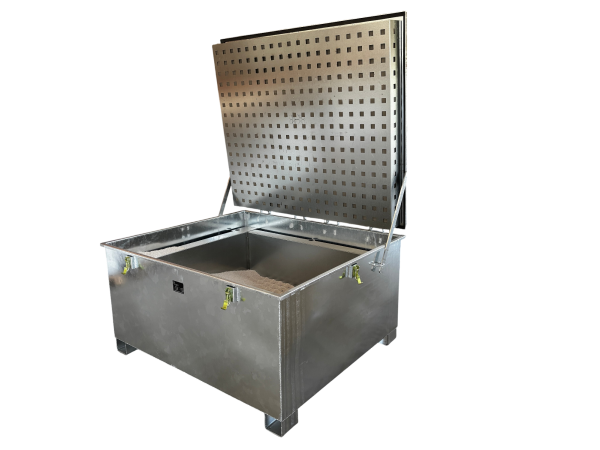- Article no: GENLABSB520

Questions about the article?
Our staff member Petra Fürbeck is happy to help you:
+49 (0) 7151 - 256 4817 or info@lion-care.com
| max. net dangerous goods mass: | without specification |
| Handling the filling material: | Filling material in cushions and filling |
| Empty weight: | 568 kg |
| Max. Battery size: | 1227 x 1027 x 380 mm |
| Material name: | Steel (galvanized) |
| Volume: | 520 l |
| Packaging group: | without |
| Packaging instructions according to ADR: | without |
| ADR special provision: | without |
| UN packaging code: | without |
| Areas of application: | Prototypes, loose cells, Recycling centers |
| External dimensions: | 1680 x 1480 x 882 mm |
| Filling material: | PyroBubbles® |
| Internal dimensions: | 1247 x 1047 x 400 mm |
The Lio Guard Storage Box 520 storage container made of galvanized steel presented here is the ideal solution for users who are looking for a reliable way to safely store lithium batteries / lithium-ion batteries according to UN3090, UN3091, UN3480, UN3481. This system was developed in cooperation with a leading manufacturer of metal boxes in Europe. In addition to the storage of intact lithium batteries, the Lio Guard Storage Box 520 storage container is particularly suitable for damaged cells, which represent a significant source of danger for the environment.
Size and capacity of the battery storage container
The Storage Box 520 storage container is a lockable steel container with an insert inside for the safe storage of lithium batteries / lithium-ion batteries. The container has a total volume of 520 liters. The maximum permissible total weight is 968 kg, the empty weight is 520 kg. The insert is non-removable and also ensures that the cells are effectively kept away from the outer walls of the container.
The Lio Guard Storage Box 520 storage container has external dimensions of 1680 x 1480 x 882 mm and internal dimensions of 1247 x 1047 x 400 mm (length x width x height). The maximum recommended size for hazardous goods is 1227 x 1027 x 380 mm. This area of the inner container can be used for storing the lithium-ion batteries. The box can be driven under from all sides with industrial trucks and has a ground clearance of 120 mm. The lid has a lid support, which makes loading easier.
A coordinated system thanks to the use of PyroBubbles®
Individual and expensive storage solutions can be replaced by using this economical and standardized product. The boxes are permanently reusable. The box is filled between the inner wall and the insert with approx. 160 kg of the fire retardant PyroBubbles®, which can form a closed and thermally insulating layer around a fire source. The lid of the box contains 37 large PE filling cushions with PyroBubbles®, each weighing 2.1 kg (7.8 liters). These cushions are surrounded by thin, needled polyethylene (PE) film, which dissolves in the event of a fire and can thus release the extinguishing agent. The environment is thus optimally protected from damaged lithium batteries / lithium-ion batteries. Even in the event of a chain reaction (thermal runaway), the environment is reliably protected.
Certification and guidelines
There are currently no legal regulations for the storage of lithium batteries / lithium-ion batteries. By purchasing this storage system, however, you are optimally equipped for any regulations that may arise.
Future-oriented
Lithium-ion batteries will be indispensable in all industrial applications in the coming years. However, if used improperly, batteries can pose a potential hazard during production, storage and transportation that should not be underestimated. By purchasing these boxes, you protect yourself against major financial losses right from the start. International customers from the automotive and energy supply sectors, among others, rely on this proven technology.
Direct comparison of the variants
| Storage Box 30 | Storage Box 90 | Storage Box 220 | Storage Box 280 | Storage Box 520 | |
| External dimensions | 600 x 400 x 750 mm | 805 x 605 x 750 mm | 1216 x 805 x 750 mm | 1216 x 1006 x 750 mm | 1680 x 1480 x 882 mm |
| Internal dimensions | 488 x 334 x 590 mm | 691 x 536 x 595 mm | 1133 x 690 x 595 mm | 1030 x 894 x 598 mm | 1562 x 1362 x 700 mm |
| Capacity | 30 l | 90l | 220 l | 280 l | 520 l |
| Empty weight | 78 kg | 131 kg | 217 kg | 251 kg | 568 kg |
| Material | Steel (galvanized) | Steel (galvanized) | Steel (galvanized) | Steel (galvanized) | Steel (galvanized) |
| Filling material | PyroBubbles | PyroBubbles | PyroBubbles | PyroBubbles | PyroBubbles |
If you have any questions, please do not hesitate to contact us. We look forward to hearing from you!
| max. net dangerous goods mass: | without specification |
| Handling the filling material: | Filling material in cushions and filling |
| Empty weight: | 568 kg |
| Max. Battery size: | 1227 x 1027 x 380 mm |
| Material name: | Steel (galvanized) |
| Volume: | 520 l |
| Packaging group: | without |
| Packaging instructions according to ADR: | without |
| ADR special provision: | without |
| UN packaging code: | without |
| Areas of application: | Prototypes, loose cells, Recycling centers |
| External dimensions: | 1680 x 1480 x 882 mm |
| Filling material: | PyroBubbles® |
| Internal dimensions: | 1247 x 1047 x 400 mm |
Das hängt von verschiedenen Faktoren ab, die man berücksichtigen muss:
- Größe der Batterie(n)
- Zustand (z.B. nicht kritisch, defekt, defekt kritisch oder Prototyp)
- Leistung
Transportboxen gibt es in vielen verschiedenen Größen und Ausstattungen. Es ist jeweils beim Produkt angegeben, für welche Verpackungsgruppe die Box geeignet ist.
Mehr dazu in unserem Blogartikel:
https://www.lion-care.com/aktuelles/blog/transportvorschriften-regeln-und-sicherheitsmassnahmen
Denken Sie auch bei nicht kritischen Batterien daran, diese vor Erschütterungen zu schützen und entsprechend Füllmaterial mitzubestellen, wenn dieses nicht bereits in der Box enthalten ist.
Ja. Sollte eine Batterie einen kritischen Zustand erreichen und einen Brand auslösen, verhindert eine Trennung der Akkus, dass dieser sich ausbreitet und multipliziert.
Grundsätzlich sollte das Dämm-/Schutzmaterial alle Seiten des Behälters auskleiden. Die Batterien werden zwischen einzelnen Schichten gelagert.
Wir haben auch Behälter im Programm, die das Schutzmaterial bereits in der Außenwand integriert haben. Hier ist keine weitere Schutzschicht notwendig.
Die technischen Grundsätze für Lager- und Transportlösungen sind sehr ähnlich. Die Transportboxen werden zusätzlich gemäß ADR umfangreichen Tests (Falltest, Brandtest …) unterzogen, um die Erfüllung der ADR-Regularien zu bestätigen. Die Verpackungsvorschriften sind umfangreich und gesetzlich geregelt.
Vergleichbare Vorschriften zur Lagerung gibt es derzeit noch nicht. Dennoch führen Hersteller von Lagerboxen regelmäßig entsprechende Test durch.
Welcher Behälter der richtige ist, hängt von der Art der zu versendenden oder zu lagernden Batterie und der Größe ab.
Wenn Sie mehr zur Lagerung und zum Transport von Batterien erfahren möchten, finden Sie in unseren Blogartikeln die Antwort:
https://www.lion-care.com/aktuelles/blog/transportvorschriften-regeln-und-sicherheitsmassnahmen
https://www.lion-care.com/aktuelles/blog/lithium-ionen-akkus-sicherer-umgang-und-richtige-lagerung
Dem Transport von Batterien liegen die ADR-Regularien zugrunde.
Um einen geeigneten Transportbehälter für Lithium-Ionen-Batterien zu finden, sind Anzahl, Größe und Gewicht, Energiedichte und Zustand der Akkus ausschlaggebende Parameter. Die Auswahl ist komplex und sollte durch entsprechend geschultes Personal erfolgen. In unserem Team haben wir einen ausgebildeten Gefahrgutbeauftragten. Sprechen Sie uns gern an.
Kunststoffbehälter sind günstiger, jedoch nicht so langlebig wie Metallbehälter. Sie eignen sich bspw. für nicht kritische Batterien, defekte Batterien, Prototypen und End-Of-Life Batterien. Sie können sowohl für die Lagerung als auch für den Transport eingesetzt werden.
Metallbehälter werden z.B. benötigt, wenn es sich um kritisch defekte Batterien handelt.
Die genauen Verpackungsvorschriften für diese Fälle finden Sie im ADR oder Sie fragen einen zertifizierten Gefahrgutbeauftragten.
Bisher gibt es keine gesetzliche Vorschrift zur Lagerung von Lithium-Ionen-Batterien, was nicht bedeutet, dass man sie ohne geeignete Schutzvorkehrungen lagern sollte.
Am besten ist es, sich bei seinem Versicherer zu erkundigen, welche Maßnahmen er im Schadensfall als geeignet anerkennt.
Zum Beispiel könnte bereits eine geeignete Box als räumliche Trennung anerkannt werden.
Einen groben Überblick erhält man in dieser VDS Publikation des GDV:
https://shop.vds.de/download/vds-3103/ccb1d439-ad9d-47cb-a2b1-ace23e155610
Lesen Sie auch unseren Blogartikel zu diesem Thema:
https://www.lion-care.com/aktuelles/blog/lithium-ionen-akkus-sicherer-umgang-und-richtige-lagerung







